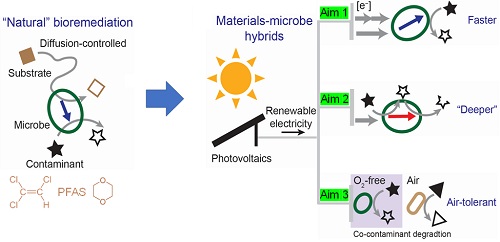Technology Profile
Researchers at the University of California (UC), Riverside and UC Los Angeles are exploring how nanomaterials powered by solar electricity can accelerate the activity of bacteria used to clean up halogenated contaminants such as chlorinated solvents, per- and polyfluoroalkyl substances (PFAS), and 1,4-dioxane in groundwater. Because the breakdown of these contaminants is normally slow with potentially harmful byproducts created in the process, the scientists are using advanced analytical and molecular tools to understand how solar electricity can stimulate bacteria to allow them to degrade halogenated contaminants more quickly and more deeply in groundwater. They also hope to tune their system to allow bacteria to degrade halogenated compounds and other co-contaminants at the same time.

| Technology | Solar-powered material-microbe interface to accelerate the activity of bacteria used to clean up contaminants. |
|---|---|
| Innovation | Incorporating new advances in nanomaterials science to optimize bioremediation leveraging solar power. |
| Contaminants and Media | Halogenated contaminants, 1,4-dioxane Groundwater |
| Principal Investigators | Yujie Men , Chong Liu |
| Institutions | University of California, Riverside; University of California, Los Angeles |
| Grant Numbers | R01ES032668 |
to Top



